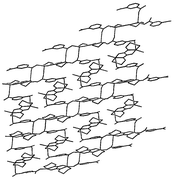Compounds [Cu2(trans-oxen)(tp)]n·2nH2O (1·2nH2O), [{Cu2(trans-oxpn)(H2O)2}{Cu2(trans-oxpn)}(isophth)2]n·7nH2O (2·7nH2O) and [Cu2(trans-oxen)(phth)]n·2nH2O (3·2nH2O) [H2oxen = N,N′-bis(2-aminoethyl)oxamide, H2oxpn = N,N′-bis(3-aminopropyl)oxamide, tp = terephthalate, isophth = isophthalate and phth = phthalate] were obtained from the self-organization of trans-oxamidato-bridged dicopper(II) building blocks [Cu2(trans-L)]2+ (L = oxen or oxpn) and phenyldicarboxylate spacers with differently oriented carboxyl groups and their crystal structures determined. All the compounds consist of solvated water molecules and 2-D polymeric coordination networks containing rectangular, H-shaped mosaics and distorted rectangular grids for 1, 2, and 3, respectively. In addition, variegated hydrogen bonds involving solvated water molecules link the 2-D nets into 3-D frameworks. New bridging modes were discovered for the three isomeric phenyldicarboxylates. Magnetic calculations on 2·7nH2O showed that the planar oxamidato bridge transmits antiferromagnetic interactions between the Cu(II) ions.

You have access to this article
 Please wait while we load your content...
Something went wrong. Try again?
Please wait while we load your content...
Something went wrong. Try again?


 Please wait while we load your content...
Please wait while we load your content...